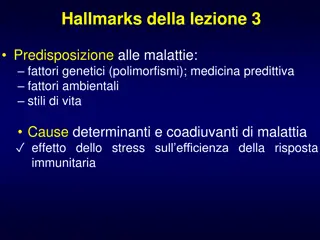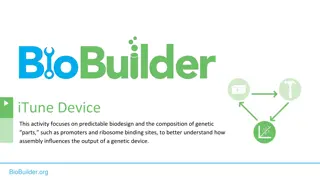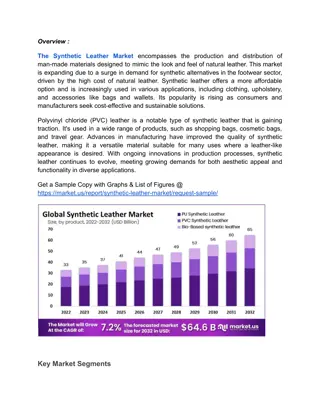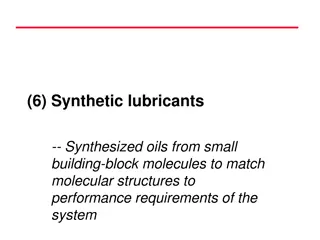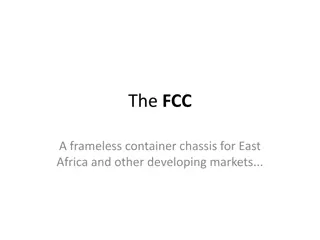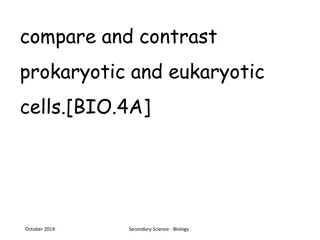Exploring Cellular Chassis in Synthetic Biology
Assumptions about cell behavior are challenged when different strains are transformed with DNA to grow in colorful ways. Synthetic Biology uses genetic engineering to construct living systems, introducing students to molecular techniques in an engineering context. Activities such as iTUNE Device and Picture This delve into genetic device behavior and circuit modeling. Students explore genetic designs in projects like Eau That Smell and Golden Bread, while examining the role of the cellular chassis in system performance in the exciting lab of What A Colorful World.
Download Presentation

Please find below an Image/Link to download the presentation.
The content on the website is provided AS IS for your information and personal use only. It may not be sold, licensed, or shared on other websites without obtaining consent from the author. Download presentation by click this link. If you encounter any issues during the download, it is possible that the publisher has removed the file from their server.
E N D
Presentation Transcript
What A Colorful World Simplifying assumptions about the cell are brought into question when different strains are transformed with DNA that makes them grow in colorful ways BioBuilder.org
Synthetic Biology Synthetic Biology uses genetic engineering techniques to construct synthetic living systems The synthetic biology approach familiarizes teachers and students with molecular biology genetic engineering microbiology methods ALL IN AN ENGINEERING SETTING What A Colorful World | BioBuilder.org
Synthetic Biology: Engineering Principles These principles and technologies extend the teaching of molecular techniques into real world, authentic applications What A Colorful World | BioBuilder.org
Design Build Test What A Colorful World | BioBuilder.org
What A Colorful World Examines the role of the cellular chassis in system performance. Students transform different strains of E. coli with DNA that turns the cells several bright colors. Students then observe how different the color intensity can be from strain to strain, despite being encoded by the same DNA sequence. iTUNE Device Examines the role of parts, such as promoters and ribosome binding sites, in predicting the output of a genetic device. The students measure -galactosidase enzymatic activity as the device s output, thereby looking through the lens of molecular genetics to predict and then evaluate a device s behavior. Picture This Three activities to explore the role of modeling in circuit design. These activities include a downloadable program to computationally vary the parameters of a genetic circuit, an exercise to mimic a genetic circuit with electronic parts, and an opportunity to send a stencil that will be turned into a bacterial photograph. Eau That Smell Compares two alternative genetic designs. Both programs should make the cells smell like ripe bananas as the cells grow. Golden Bread Explores the science, engineering and bioethics of a yeast that s genetically modified to make a vitamin-enriched food. Lab activities include PCR, yeast transformation, codon shuffling and statistical analysis of data What A Colorful World | BioBuilder.org
What A Colorful World This BioBuilder activity is a reminder that, just as you carefully consider your design for a genetic program, you also need to carefully choose the host cell, or chassis, that will run it. What A Colorful World | BioBuilder.org
What A Colorful World In this lab, you will build several color-generating systems to explore how the chassis affects the output of a designed genetic program. Because the colors are visible to the naked eye, you can easily decide whether the color outputs are different between the chassis. What A Colorful World | BioBuilder.org
What A Colorful World The DNA programs that generate purple or green pigments have already been written and assembled for you, but you will complete the final building step by inserting the DNA that encodes the programs into a few different bacterial chassis. What A Colorful World | BioBuilder.org
What A Colorful World The DNA programs come from a 2009 International Genetically Engineered Machines - iGEM project called, E. chromi, in which students from the University of Cambridge designed and engineered E. coli to produce a spectrum of pigments. What A Colorful World | BioBuilder.org
Introduction to Chassis Design Just as a car manufacturer must take into account the entire car when designing an engine, synthetic biologists must consider the entire system they are building, including the cellular environment itself. What A Colorful World | BioBuilder.org
Introduction to Chassis Design In the same way that features of cars you see on the road can vary widely, cells can vary dramatically in their: Size Shape Organelles Basic metabolic functions Consequently, choosing the best host cell, or chassis, for any engineered genetic program is an important step in the design process. What A Colorful World | BioBuilder.org
Introduction to Chassis Design Nearest Neighbor Standard Chassis A chassis is identified from nature based on its ability to do something similar to the task a synthetic biologist has in mind for a new system. A generic chassis is chosen because it either has a minimal number of natural components or it is well understood and highly engineerable. What A Colorful World | BioBuilder.org
Introduction to Chassis Design Nearest Neighbor Standard Chassis For example, the bacterium Ralstonia eutropha naturally converts carbon dioxide into energy-storing polymers. This makes the chassis attractive to engineers who want to generate energy-storing molecules like biofuels. Some research groups are using engineered E. coli to make biofuels. These researchers see E. coli as an attractive platform for many purposes, including the conversion of carbon dioxide and electrical energy into isooctane, even though this reaction is unlike anything else these cells normally do. What A Colorful World | BioBuilder.org
Engineering a Living Biosensor E.chromi was designed to detect heavy metals such as arsenic and mercury, which pose significant health risks and contaminate many waterways around the world. The iGEM team wanted their engineered biosensor to report both the identity and the concentration of several metals in a water sample. The presence of metals would trigger one or more color outputs. Because the colors were pigment-based, the readout of their system was visible to the naked eye, alleviating the need for specialized equipment and thus making it easy to use. What A Colorful World | BioBuilder.org
Engineering Pigment Production Given the wide variety of natural colors found in the living world (orange carrots, purple flowers and so on), the iGEM team had plenty of sources for their color generating devices. Whenever possible, they focused on genetic pathways that could be modified to produce more than one color. Carotenoids, for example, are a family of pigments that are structurally related and so can be modified to appear yellow, red or orange. What A Colorful World | BioBuilder.org
Engineering Pigment Production When the violacein family of pigments are produced, the cells can appear purple or green, depending on a relatively small genetic change. Normally the genetic pathway uses five enzymes (VioA, VioB, VioC, VioD and VioE) converts an abundant and natural compound, tryptophan, to produce violacein, a purple pigment. When the VioC gene is removed, however, the pathway branch is blocked and the final conversion to violacein can t occur. In this case, the system s endpoint becomes proto-violacein, which is a green pigment. What A Colorful World | BioBuilder.org
Engineering Pigment Production Logic gates and Truth tables can be used to summarize system s behavior. Both show that VioA, VioB, VioD and VioE are necessary for generating the green pigment and that the addition of the VioC gene gives rise to the purple pigment output. What A Colorful World | BioBuilder.org
Emergent Behavior In building their system, the iGEM team members presumed that all the color-generating devices would predictably generate a visible palette of colors. To the team s surprise and chagrin, there were idiosyncrasies for each pigment-generating device. Some strains expressing the color-generating devices were colorful and healthy while others less stable and more sick. To examine the impact of the chassis on the behavior of the genetic system, the team experimented with a number of bacterial strains. You will continue this investigation to identify what factors make a chassis the best one for running each device. What makes identical genetic programs behave differently, even in two closely related cellular chassis? What A Colorful World | BioBuilder.org
Engineering Challenge The Colorful World experiment will test for reliable production of purple and green pigment generators. Each genetic program will be introduced into two closely related E. coli strains so the number of transformants and their colors can be compared. Strain 4-1 = E. coli K12 (NEB catalog# ER2738) = F proA+B+ lacIq (lacZ) M15zzf::Tn10(TetR)/ fhuA2 glnV (lac-proAB) thi-1 (hsdS-mcrB)5 4-1 Strain 4-2 = E. coli BL21 (NEB catalog# C2523) =: fhuA2 [lon] ompT gal sulA11 R(mcr-73::miniTn10-- TetS)2 [dcm] R(zgb-210::Tn10--TetS) endA1 (mcrC-mrr)114::IS10 4-2 The strains of E. coli you ll work with are routinely used in laboratories around the world to study the behavior of bacterial cells and to perform molecular biology techniques. They offer the beginnings of a standard chassis for synthetic biology. The genetic differences between the two strains are known and are listed above. What A Colorful World | BioBuilder.org
Bacterial Transformation Experimental Method The process of introducing new DNA into bacterial cells is called transformation. The E. coli strains you ll study do not naturally take up new DNA in from the environment. To prepare the cells for this experiment, they must be treated with a CaCl2salt solution that makes the cells porous. New DNA can be introduced through the pores when the cells are in this competent state. What A Colorful World | BioBuilder.org
Bacterial Transformation The DNA that encodes the color-generating devices also encodes the ampicillin resistance gene. Because the media contains ampicillin, only the cells having the color-generating device should grow. After one night of growth, each cell that survived the transformation and antibiotic exposure will have grown into a colony of cells visible to the naked eye. No DNA +DNA The ampicillin is used to select for the cells that have been transformed. Cells that have not taken in the DNA will not grow on the ampicillin-containing media. What A Colorful World | BioBuilder.org
Experimental Controls 4-1 4-2 CONTROLS Though they are not explicitly described in the lab protocol, several control reactions are easy to include in this experiment. Including controls is a big part of good experimental design. Controls make it possible to isolate variables and troubleshoot problems encountered while doing experiments. What A Colorful World | BioBuilder.org
Experimental Controls As a NEGATIVE CONTROL FOR GROWTH on ampicillin, you can use any leftover competent cells from step 6 in the protocol that follows. These leftover cells will not have been exposed to plasmid DNA but they can be otherwise treated identically to the experimental samples. No colonies should grow when these control reactions are plated on media that contains ampicillin. If growth IS observed, then perhaps the media s antibiotic has degraded or a reagent (e.g. the media or the the cells themselves) have been contaminated. A POSITIVE CONTROL FOR GROWTH is not included with the instructions but can be run by plating any of the leftover transformation mixes on media that contains no antibiotics. Cells should grow as a lawn on this non-selective media. If NO growth is observed, then perhaps the cells did not survive the transformation treatment (e.g. perhaps the water bath was boiling rather than 42 ) or the antibiotic in the selection media is not the correct one (e.g. tetracycline rather than ampicillin) What A Colorful World | BioBuilder.org
Good Luck! BioBuilder.org


